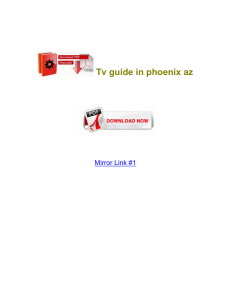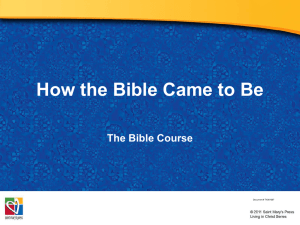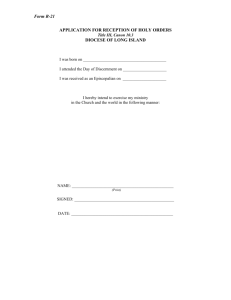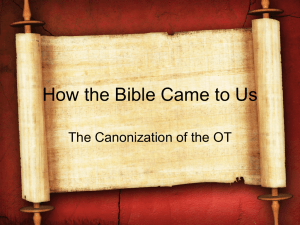OT Canon
advertisement
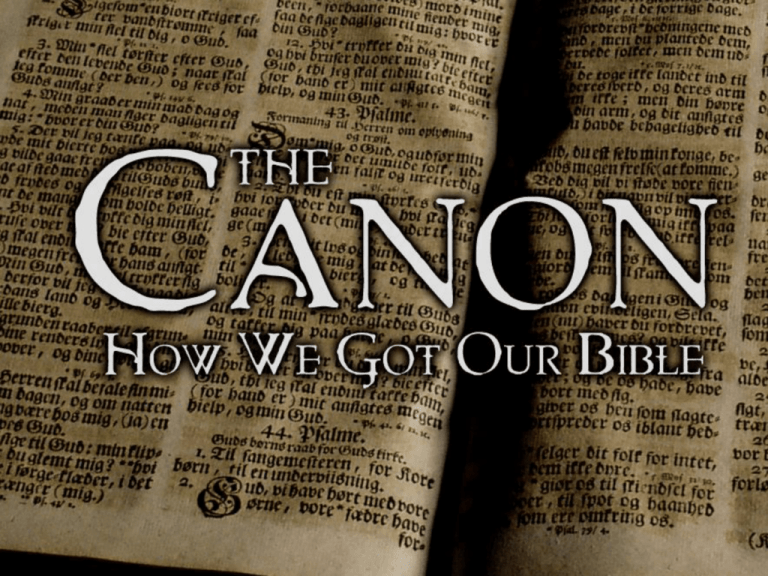
A few preliminary thoughts: 1. Bible remains the world’s best seller. 2. Bible remains most neglected book. 3. Bible remains the piece of literature to be most trusted. 4. Bible is constantly under attack. Biblia- “the books” Papyrus Codex Marzeah Papyrus Biblical Languages 1. Hebrew 2. Aramaic 3. Greek Uncials Miniscules thussaithglenitishig htimewetookourbi blesliterallyandseri Kanwn- “A measuring stick” Where does the authority originate? 1. “Authority for the Canon comes from man.” 2. “Authority for the Canon comes from the Church.” 3. “Authority for the Canon comes from God.” OT Canon Begins with the written words of God (Ex 31:18) Grew in size throughout the time of Israel’s history, written by those who fulfilled the office of prophet (Deut 31:24-26; 1 Sam 10:25; Jer 30:2) Continued until about 435 BC Accepted by Jesus and his contemporaries Confirmed by the church as early as AD 170 OT Canon God’s 1st communication was oral. Moses Exodus 17:14 Exodus 24:4 Exodus 34:27-28 Numbers 33:2 Deut. 31:9, 24 Deut. 31:22 Moses wrote the Torah The History of Ancient Writings Proto-Sinaitic Inscriptions The History of Ancient Writings 1. Stone Gezer Calendar Moabite Stone The History of Ancient Writings 2. Clay A Babylonian tablet from 87 B.C. reports the arrival of the comet now known as Halley. Fragment of a clay tablet from the library of Ashurbanipal at Nineveh, with an Assyrian account of the Flood The History of Ancient Writings 3. Wood & Wax Wooden tablets often had an inlay of wax to write upon. The Assyrians used these tablets and bind them together like a modern day book and call it a “Codex.” The History of Ancient Writings 4. Metal “‘The Lord bless you and keep you; the Lord make his face shine upon you and be gracious to you; the Lord turn his face toward you and give you peace.’” Numbers 6:24-25 The History of Ancient Writings 5. Ostraca Broken pottery was often used as scratch paper Why did Moses write Scripture? 1. God’s method of preservation of canon 2. Delivery to other places Jeremiah 29:1 Jeremiah 36:1-8 3. Future memorial to Israel Exodus 17:14 4. A witness Deuteronomy 31:24-26 OT Canon TaNaKh T – Torah (The Law) N – Neviim (The Prophets) K – Kethubim (The Writings) OT Canon Closing of the Torah (Law) •Canonical by times of Ezra & Nehemiah •5th Century BC Closing the Neviim & Kethubim •3rd Cent. BC: Translated into Greek (LXX) OT Canon (Apocrypha)," And also that he [Judas Maccabaeus] founded a library and collected the books about the kings and prophets, and the writings of David, and letters of kings about votive offerings. In the same way Judas [Maccabaeus] also collected all the books that had been lost on account of the war which had come upon us, and they are in our possession. So if you have need of them, send people to get them for you.” 2 Maccabees 2:13b-15 (RSV) OT Canon Difference between Jewish OT and Canonical OT Jewish (22 Books) Law Prophets Former Prophets – Joshua, Judges, Samuel & Kings Latter Prophets – Isaiah, Jeremiah, & Ezekiel The “Twelve” Writings Note: Ends with 2 Chronicles OT Canon “‘And so upon you will come all the righteous blood that has been shed on earth, from the blood of righteous Abel to the blood of Zechariah son of Berekiah, whom you murdered between the temple and the altar.’” Matthew 23:35 “‘From the blood of Abel to the blood of Zechariah, who was killed between the altar and the sanctuary. Yes, I tell you, this generation will be held responsible for it all.’” Luke 11:51 What About Jamnia? AD 90: Council of Jamnia •Not a major council •Limited discussion on Ecclesiastes and Song of Songs Canon fixed prior to birth of Christ •Matthew 4:1-4 “Then Jesus was led by the Spirit into the desert to be tempted by the devil. After fasting forty days and forty nights, he was hungry. The tempter came to him and said, ‘If you are the Son of God, tell these stones to become bread.’ Jesus answered, ‘It is written: 'Man does not live on bread alone, but on every word that comes from the mouth of God. '’” Principles & Factors Determining the OT Canon 1. Prophetic Authorship (Hag 1:3; Zech. 1:1) 2. Testimony of the Holy Spirit 3. Providential Care 4. Validation By Christ (Matt 21:42; 26:54) 4 Categories of Religious Writings 1. Homolegomera 2. Antilegomera 3. Apocryphal 4. Pseudepigrapha The Apocrypha The Intertestament Period •Alexander the Great died in 323 BC •Palestine under severe pressure •Constant revolts •Hellenization of culture The Apocrypha Why not canonized? 1.Never included in Old Testament canon 2. Never accepted by Jesus/Apostles 3. Never accepted by early Jewish writers 4. No evidence of inspiration 5. Errors 6. Uncertainty 7. Objections not overcome 8. Unorthodox Doctrine Problem: Doesn’t Jude quote non-canonical literature? “(v. 9) But even the archangel Michael, when he was disputing with the devil about the body of Moses, did not dare to bring a slanderous accusation against him, but said, ‘The Lord rebuke you!’… Enoch, the seventh from Adam, prophesied about these men: ‘See, the Lord is coming with thousands upon thousands of his holy ones to judge everyone, and to convict all the ungodly of all the ungodly acts they have done in the ungodly way, and of all the harsh words ungodly sinners have spoken against him.’” Jude 1:9, 14-15 Qumran Dead Sea Scrolls NT Canon Begins with the writings of the apostles (Jn 14:26; 16:13-14) Claims authority (2 Pet 3:2; 1 Cor 2:6-10) Apostles treat the writings of other apostles as part of Scripture (2 Pet 3:15-16; 1 Tim 5:17-18 with Luke 10:7) NT Canon Includes some writings of those very close to the apostles (Mark, Luke, Acts, Jude) The author of Hebrews is not known, but the church accepted this book early on as selfattesting Completed with the death of the apostles; no further revelation awaits (Heb 1:1-2; Rev 22:1819) Confirmed by the church as early as AD 367 NT Canon “But the Counselor, the Holy Spirit, whom the Father will send in my name, will teach you all things and will remind you of everything I have said to you…But when He, the Spirit of truth, comes, he will guide you into all truth. He will not speak on his own; he will speak only what he hears, and he will tell you what is yet to come.” John 14:26; 16:13 5 Periods of NT Canonization 1. First Century •Scriptures were written. •Scriptures were to be publicly read. 1 Thessalonians 5:27 •Paul commends their acceptance 1 Thessalonians 2:13 •Paul insists his writings are from God. Colossians 4:16 •Paul’s letters included with “other Scriptures” 2 Peter 3:15-16 AD 95 Clement of Rome 5 Periods of NT Canonization 2. First half of second century Ryland Fragment Ignatius Polycarp Marcion 5 Periods of NT Canonization 3. Second half of second century “The Word gave us the Gospel in fourfold shape, but held together by one Spirit.” Muratorian Fragment AD 170 4. Third century Clement ~ Irenaeus Irenaeus Origen Tertullian 5. Fourth century Constantine Eusebius Athanasius The Big 3 Codices Codex Alexandrinus Codex Sinaiticus British Library British Library Codex Vaticanus Vatican Library Summary 100 AD: •All 27 books of the New Testament were in circulation and all but Hebrews, 2 Peter, James, 2 John, 3 John and Revelation were universally accepted 100-400 AD: •6 “disputed” books accepted. •A number of other books were read in a few churches at various times: Shepherd of Hermes, 1 Clement, Didache, Epistle of Barnabas, Wisdom of Solomon, Apocalypse of Peter Principles & Factors Determining the NT Canon 1. Divine Inspiration Inspiration is not… 1. Human achievement 2. Human thoughts and ideas 3. Human responses to God’s leading 4. Divine dictation Principles & Factors Determining the Canon continued… 1. Divine Inspiration 2. Authorship 3. Orthodoxy 4. Obedience 5. Cohesiveness Principles & Factors Determining the Canon continued… 6. Acceptance 7. Relevance 8. Universality 9. Sacred Objects Bottom Line The believers (the church) DID NOT establish the canon, but simply bore witness of God’s leading by recognizing their authority! The Nag Hammadi Collection The Nag Hammadi Collection Gospel of Thomas Supposedly written by the Apostle Thomas Unanimously rejected Confusion The Nag Hammadi Collection Gospel of Philip “All descriptions of artwork, architecture, documents, and secret rituals in this novel are accurate.” ~Dan Brown What People Say About the Bible 1. The Bible is just a bunch of stories. 2. The Bible is filled with contradictions. 3. The Bible is outdated. 4. The Bible is not scientific. 5. The Bible is a man-made book. Evidence for Reliability of the Bible 1. External Evidence •Preeminence Among Literature 1) Preeminent in circulation 2) Preeminent in influence 3) Preeminent among religious writings •Preservation Under Attack 1) Attack of man 2) Attack of time A. Number of Manuscripts B. Number of Variants C. Time gap between originals and earliest copies •Proof From Archeology 2. Internal Evidence •Amazing Agreement •Total Consistency 1) Supposed contradictions of message 2) Supposed contradictions of numbers 3) Supposed parallel story contradictions 4) Supposed historical contradictions 5) Supposed scientific contradictions •Fulfilled Prophecy 3. Experiential Evidence •The Bible is gripping. •The Bible is comforting. •The Bible is convicting. •The Bible is freeing. “Heaven and earth will pass away, but my words will never pass away.” Mark 13:31 “I came that you might have life, and have it to the full." John 10:10b Man (Sinful) Sin separates man from God God (Holy) "All have sinned and fall short of the glory of God." Romans 3:23 Good Works Man (Sinful) Religion Philosophy Morality God (Holy) “But God demonstrates his own love for us in this: While we were still sinners, Christ died for us." Romans 5:8 Man (Sinful) Jesus Christ God (Holy) "To all who received Him, to those who believed in His name, He gave the right to become children of God." John 1:12 Man (Sinful) Jesus Christ God (Holy) Special Terms • • • • • • • • Apocrypha apostle canon canonical covenant God-breathed history of redemption self-attesting

